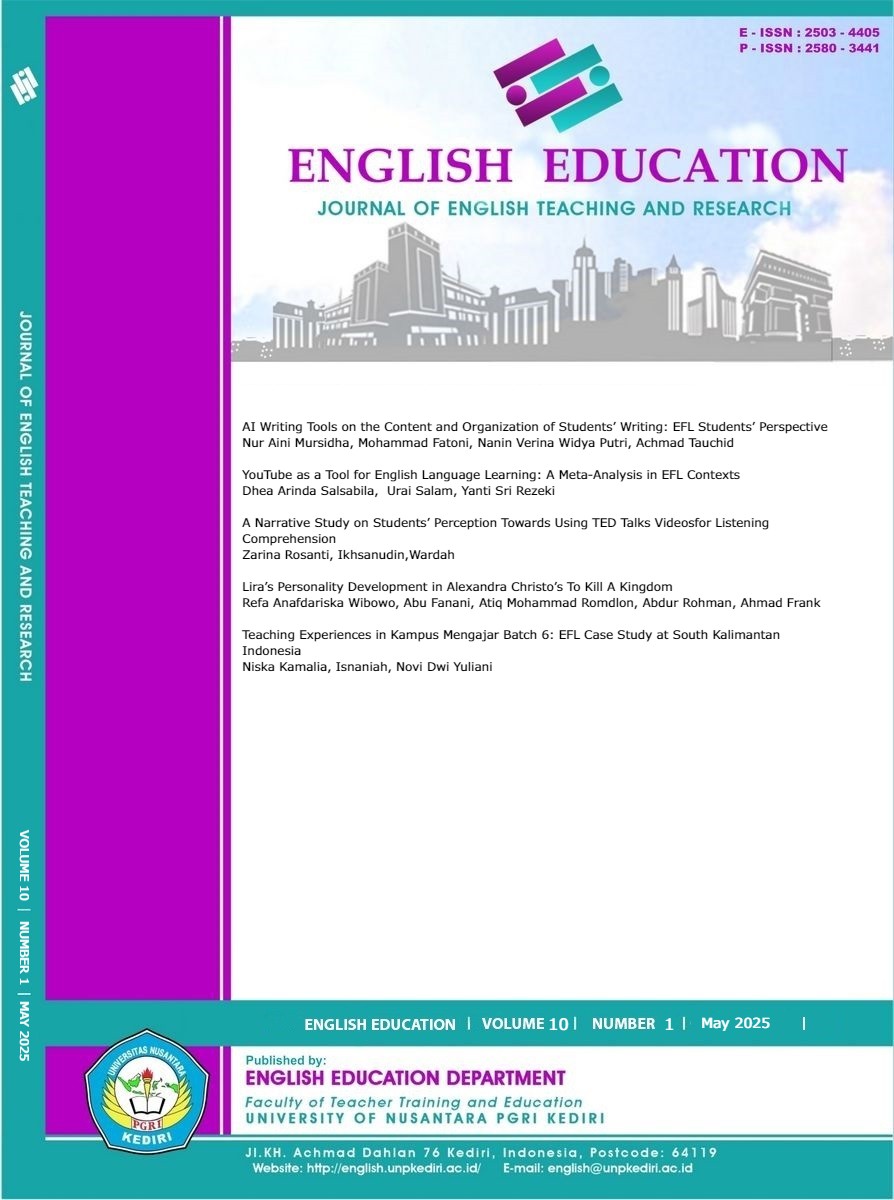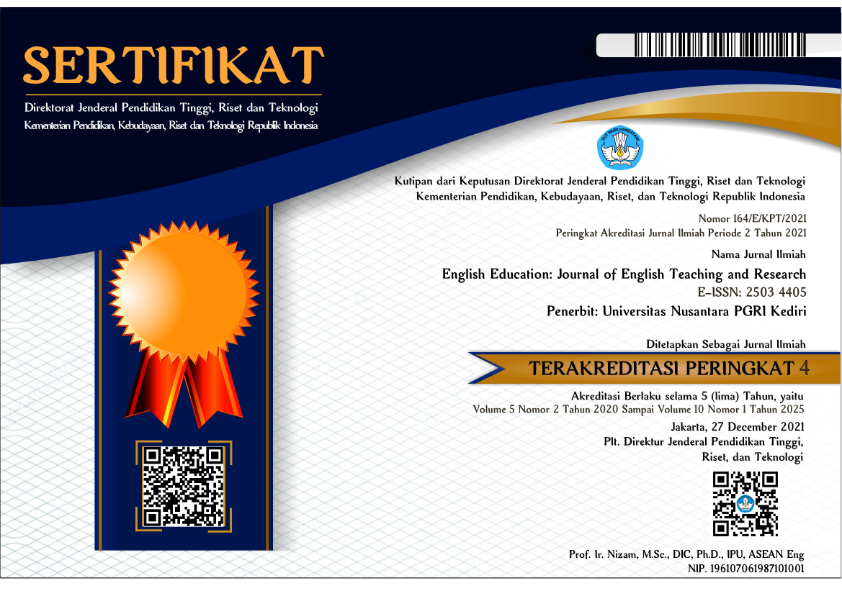AI Writing Tools on the Content and Organization of Students’ Writing
EFL Students’ Perspective
DOI:
https://doi.org/10.29407/jetar.v10i1.23626Keywords:
Writing, Technology, AI, Content and OrganizationAbstract
Writing English is a problem for final semester EFL students to complete their thesis. So AI technology becomes a tool that can improve their writing. Researchers conducted this research on three students of English language education at Nahdlatul Ulama Sunan Giri University to find out what AI tools most often use and their perspectives about AI in the content and organization of writing. This research used a qualitative approach through semi-structured interviews. Researchers collected data for this research by conducting pre-observations regarding EFL students who got high writing scores in the previous semester. The first result of this research is the AI tool they used most often was Grammarly, followed by other AI QuillBot, Perplexity AI, DeepL Translator, and Chat GPT. The second result is the respondents gave the positive perspective: AI tools can support, improve and simplify their writing in preparing their theses, and the negative perspective: AI tools must use stable internet data access, usage restrictions and even some AI tools are only intended for premium users. This research can help teachers in the teaching process and development in writing with the help of AI tools. Recommendation for further researchers are to develop this research by using comparison classes and expanding the scope of research and future researchers can develop it by using more research instruments to further strengthen the results.
Downloads
References
Ariyanti, A. (2016). The Teaching of EFL Writing in Indonesia. Dinamika Ilmu, 16(2), 263–277. https://doi.org/10.21093/di.v16i2.274
Astuti, D., Darmahusni, Sumarni, S., & Suseno, M. (2023). The Use of Grammarly in the Academic Writing of Undergraduate Students : Advantages, Weaknesses, and Challenges (Systematic Review). English Language and Literature International Conference (ELLiC) Proceedings, 6, 593–607. https://jurnal.unimus.ac.id/index.php/ELLIC/article/view/12570
Bareis, J., & Katzenbach, C. (2022). Talking AI into Being : The Narratives and Imaginaries of National AI Strategies and Their Performative Politics. 47(5), 855–881. https://doi.org/10.1177/01622439211030007
Fatoni, M. (2021). Students’ Perceptions on Using Zoom Application in Debate Course during Crisis Remote Teaching. New Language Dimensions, 2(2), 88–95. https://doi.org/10.26740/nld.v2n2.p88-95
Fitria, T. N. (2021). “ Grammarly ” as AI -powered English Writing Assistant : Students ’ Alternative for English Writing. 5(1), 65–78. https://doi.org/10.31002/metathesis.v5i1.3519
Junianti, R., Pratolo, B. W., & Tri Wulandari, A. (2020). The Strategies of Learning Writing Used by EFL Learners at a Higher Education Institution. Ethical Lingua: Journal of Language Teaching and Literature, 7(1), 64–73. https://doi.org/10.30605/25409190.131
Klimova, B. (2017). The Importance of Writing * Blanka Frydrychova Klimova. March. https://doi.org/10.15373/22501991/JAN2013/4
Linh, T. T. M., Thi, N., & Ha, T. (2021). The Impacts of Technology-based Communication on EFL Students’ Writing. Asia CALL Online Journal, 12(5), 54–76. http://eoi.citefactor.org/10.11251/acoj.12.05.005EOI:http://eoi.citefactor.org/10.11251/acoj.12.05.005
Ningrum, S. (2023). ChatGPT’s Impact: The AI Revolution in EFL Writing Full Paper. Borneo Engineering & Advanced Multidisciplinary International Journal (BEAM, 2(September), 32–37. https://beam.pmu.edu.my
Putri, R. (2021). An Analysis on the Students’ Error in Writing Report Text at Eight Grade STudents of SMP N 6 Timang Gajah. 5(1), 10–19.
Sakkir, G. (2022). Information Technology Used by Millennial Good English Language Learners in an Indonesian University to Improve their English Skills.
Sumakul, D. T. Y. G., Hamied, F. A., & Sukyadi, D. (2022). Students ’ Perception s of the Use of AI in a Writing Class. 624, 52–57.
Syahnaz, M., & Fithriani, R. (2023). Utilizing Artificial Intelligence-based Paraphrasing Tool in EFL Writing Class: A Focus on Indonesian University Students’ Perceptions. Scope : Journal of English Language Teaching, 7(2), 210. https://doi.org/10.30998/scope.v7i2.14882
Widiati, U., Rusdin, D., & Indrawati, I. (2023). The impact of AI writing tools on the content and organization of students ’ writing : EFL teachers ’ perspective The impact of AI writing tools on the content and organization of students ’ writing : EFL teachers ’ perspective. Cogent Education, 10(2). https://doi.org/10.1080/2331186X.2023.2236469
Downloads
Published
Issue
Section
License
Copyright (c) 2025 Nur Aini Mursidha, Mohammad Fatoni, Nanin Verina Widya Putri, Ahmad Tauchid

This work is licensed under a Creative Commons Attribution-ShareAlike 4.0 International License.
Authors who publish with this journal agree to the following terms:
- Copyright on any article is retained by the author(s).
- The author grants the journal, the right of first publication with the work simultaneously licensed under a Creative Commons Attribution License that allows others to share the work with an acknowledgment of the work’s authorship and initial publication in this journal.
- Authors are able to enter into separate, additional contractual arrangements for the non-exclusive distribution of the journal’s published version of the work (e.g., post it to an institutional repository or publish it in a book), with an acknowledgment of its initial publication in this journal.
- Authors are permitted and encouraged to post their work online (e.g., in institutional repositories or on their website) prior to and during the submission process, as it can lead to productive exchanges, as well as earlier and greater citation of published work.
- The article and any associated published material is distributed under the Creative Commons Attribution-ShareAlike 4.0 International License








 Article template
Article template



